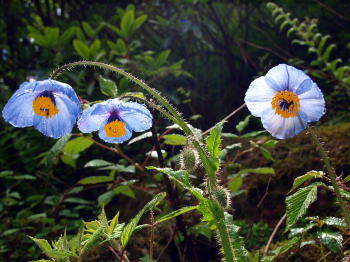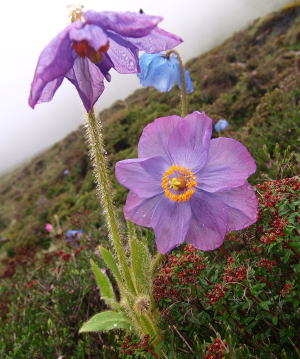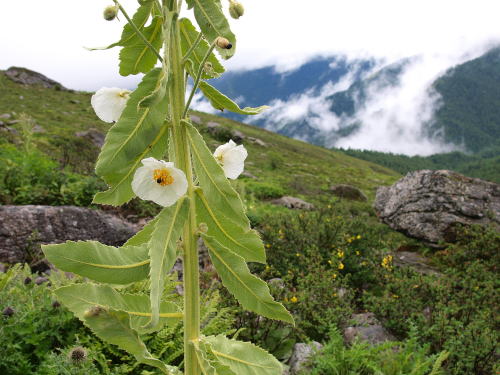
The Kingdom of Bhutan has been preserving the environment and traditions as well as promoting modernization and democratization under the national policy of Buddhism and Gross National Happiness (GNH). It has been holding untouched nature in exchange for the inconvenience. It may be the last paradise on the earth for nature lovers.
For the purpose of watching all the blue poppies (Meconopsis) in the country I trekked mid-western regions of Bhutan for one month from mid-June, when the whole country is covered with thick monsoon clouds.
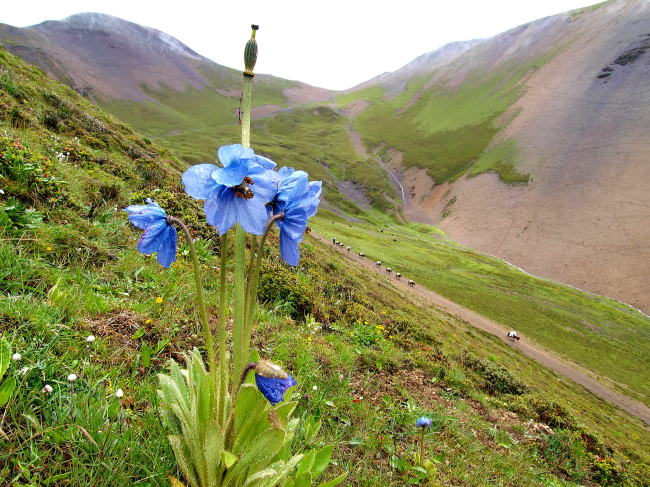 |
Meconopsis simplicifolia var. grandiflora From its entire leaf the flower is named simplicifolia, and from big petals named variants grandiflora has many petals. It looks very gorgeous. While M. simplicifolia is widely distributed from Tibet to Bhutan and Nepal, the individual flower is separately blooming without making a colony. The col behind is Nyili la(pass) located between Jomolhari Base Camp and Lingshi. The altitude alt.s 4870m. Mo Chu (river) starts to flow just under the mountain pass and goes to Punakha. A caravan with foods and daily goods on the horse back goes through the pass. (East of Nyili La, atl. 4760m) |
(1) Bumthang = Dur hot spring = Menchugan round trip (June 17th to 27th)
(2) Haa-Rigona Lake-Haa circuit tour(June 30th to July 5th)
(3) Sele La (July 6th)
(4) Gunitzawa-Jomolhari BC (Jangothang) = Tsophu lake-Lingshi-Yale La-Thimphu (July 7th to 17th)
(5) Haa (Shana) = Tego La = Sele La = Haa round trip (July 18th to 19th)
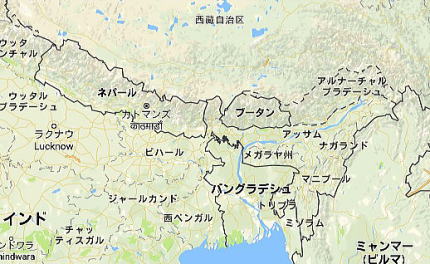
(Detail of Mid-western Bhutan)
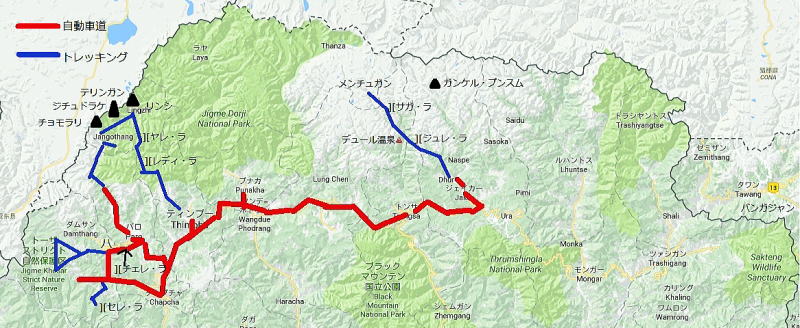 (from Google map)
(from Google map)(1) Bumthang = Dur hot spring = Menchugan (round trip)
This route located in the north of Jakar, the prefectural capital of Bumthang Province. Our trekking started from Dhur. In the beginning we went through the forest. Fortunately there were no leeches because it was over 3000m above sea (though there were tigers and bears ...).
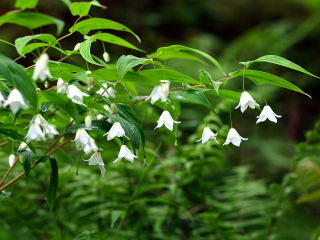 |
Streptopus paraimplex (Liliaceae) It seems that small bells are hanging and bears bright red fruits in the fall. Same type of flower is seen in sub-alpine zone of Japan. (Chokchoma campsite, alt. 3200m) |
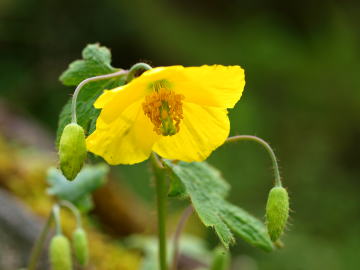 |
Cathcartia villosa (Papaveraceae) This is the first poppy I encountered during the trek. In the previous classification, it was a member of the blue poppy (genus Meconopsis). However, it is currently reclassified in the genus Cathcartia of Papaveraceae. (North of Chokchoma campsite, alt. 3540m) |
From the 2nd day of the trekking blue poppies were appearing.
|
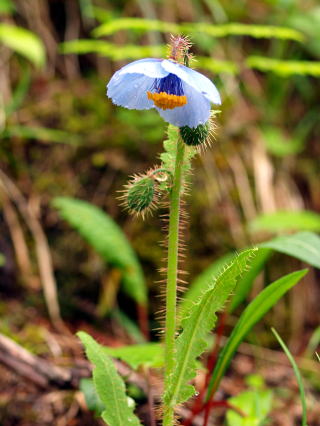 (between Chokchoma and Tsochenchen alt. 3700m) |
||||||||
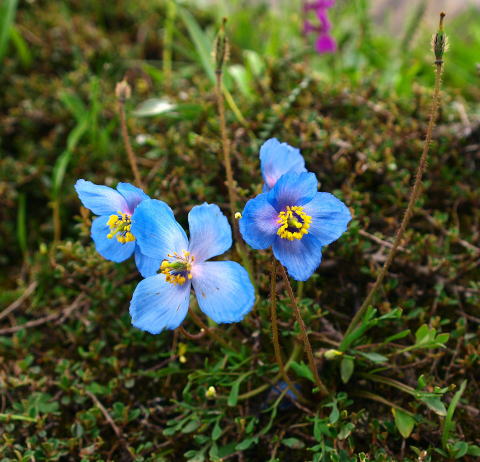 |
Meconopsis bella subsp. subintegrifolia It is distributed through Central Bhutan to East India (Arunachal Pradesh) and often seen on the rocks where water drips. There are no thorns on the stems and leaves. There are some variations in color and leaf shape. At this place there was wine color flower and white color one. Also there was flower with spoon-shaped leaves and laciniated in the shape of ones. (Both are in the middle of Chokchoma and Tsochenchen alt. 3700m) |
||||||||
M. bella in wine color 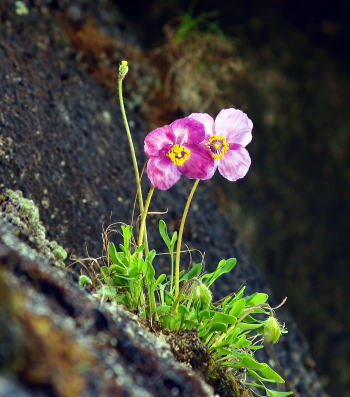 |
M. bella in white (maybe albino)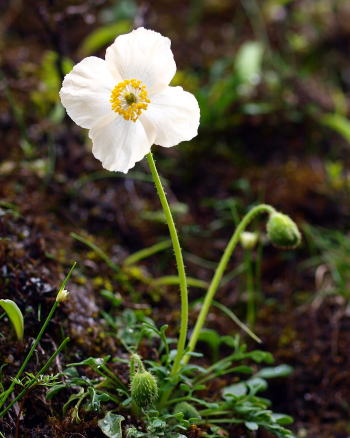 |
Two days later we also met M. bella with spoon-shaped leaves at Jule La, which is close to its type species.
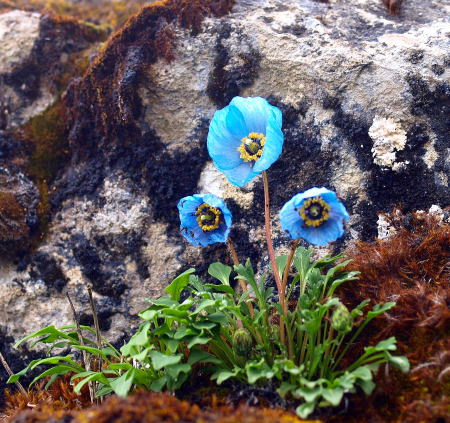 (Jule La, alt. 4300m) |
We found other rare flowers, two types of Cypripedium near by. This area looked like a hotspot of rare species.
| Cypripedium Himaraicum | Cypripedium tibetacum |
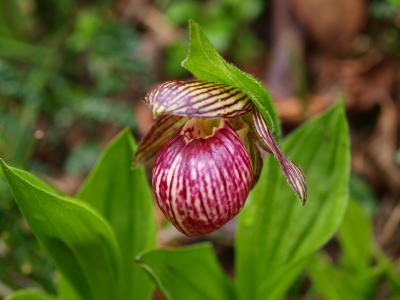 |
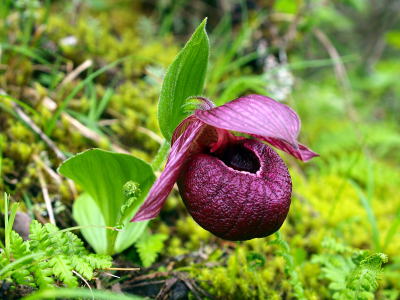 |
The rhododendrons were in full bloom along Tsochenchen valley. While when we ascended it was in the fog, we had luckily fine and sunny day on our return trip.
The rocky peak with snow in the center is 5300m high above the sea, and beyond the peak there is Gankel Punsum (alt. 7570m), the highest peak in Bhutan and the highest unexplored peak in the world.
There is a yak cabin in the forest over the rhododendron, and the smoke for breakfast is rising. The trekking course continues to the left of the back of the valley.
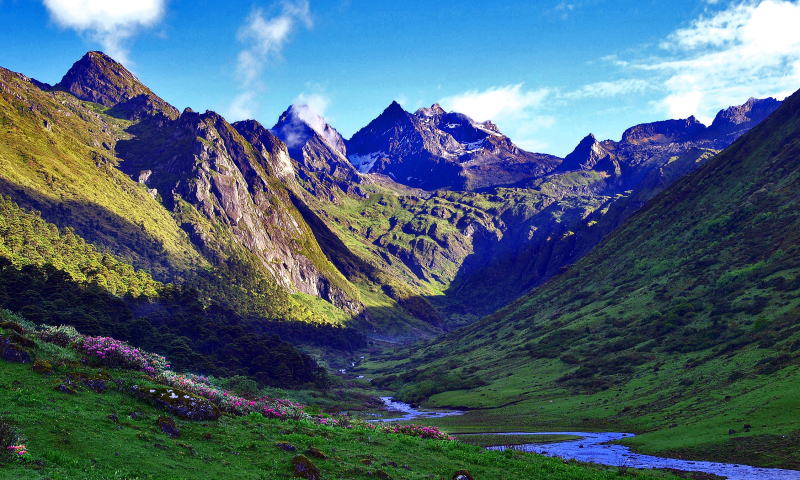 |
|||||||||||||
|
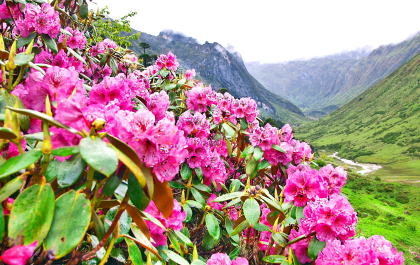
|
||||||||||||
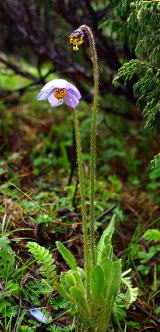 |
Meconopsis simplicifolia subsp. simplicifolia This is the type species of M. simplicifolia. The height is 60 to 70 cm. It blooms one flowers on one stem by popping out of the bush of Cypress and Berberis. Sometimes it is bitten from the middle of the stem. (North of Tsochenchen, alt. 4100m) |
At the first hurdle of the trek, passing Jule La (alt. 4550m), I had a mild high-altitude illness and was not able to move forward easily.
Yellow Meconopsis were in full bloom around this pass and on the slope on the left bank of Jule Tso (lake).
Meconopsis paniculata
|
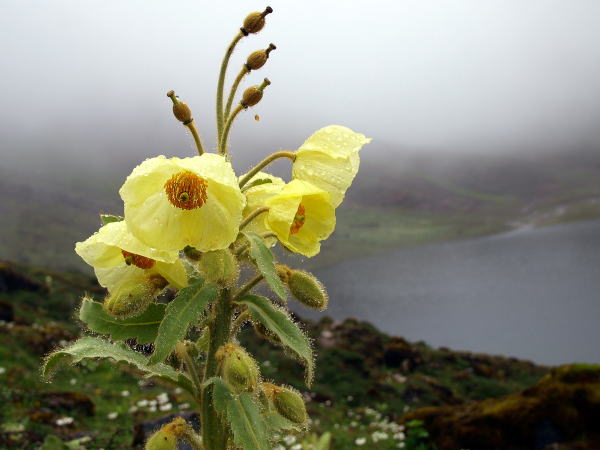 |
M.paniculata had disappeared on the way from Jule Tso to Kuto La (alt. 4500m), but instead, Meconopsis horridula, the typical blue poppy, began to appear on both sides of the trail. Though I didn't notice on my ascend due to altitude-illness and earlier to flower. But on my return trip I enjoyed the horridulas just starting to bloom. In August this trail would be a flower road of M.horridula.
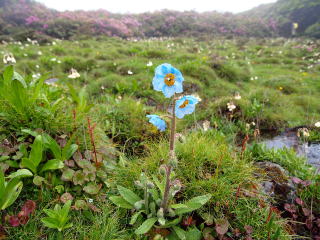 |
Meconopsis horridula subsp. drukyulensis M. horridula is widely distributed from China's Qing-hai province to Tibet, to Nepal, and to Bhutan. The flower colors are not only blue, but also pink and yellow. There are many variants. This subspecies is unique in Bhutan. (West of Kuto La, alt. 4200m) |
After 1200m descending down on the muddy road from Kuto La we arrived Dur hot springs where is on the bank of Mande Chu flowing from the glacial lake of Gankel Punsum.
As same as old Japanese spa, local people come to the spa for about a week with their own food. I also stayed here one day to curing my high-altitude illness.
| Hot-spring hut | 100% pure from the source (also drinkable) | |
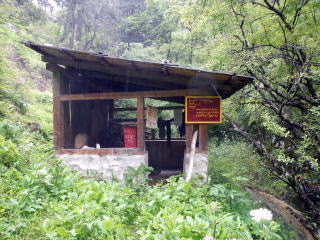 |
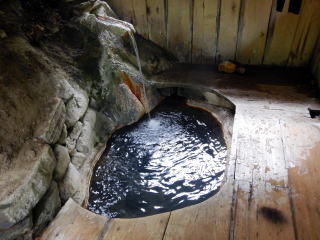 |
Fortunately my illness was cured, but this time I got food-poisoned with a fresh salad I took that night, and I couldn't eat anything. Ascending 1200m again to Walthang pasture in the rain with painful feeling. I regretted my challenge at passing Nepu La (alt. 4500m) just before Walthang.
And the next day, we crossed the highest point in this trek, Saga La (alt. 4820m), and arrived the place where pink poppies were blooming. This is the highlight of this trek.
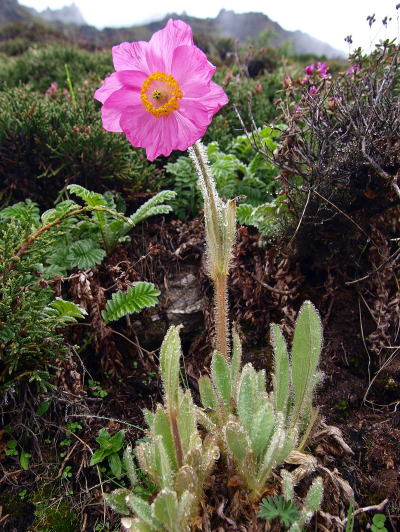 |
Meconopsis sherriffii
|
|||
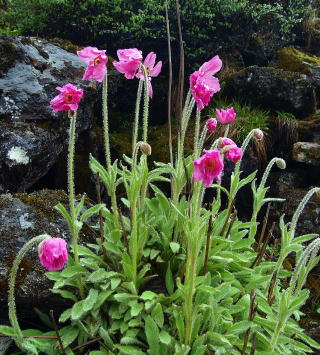 |
There was a new finding. I found some M. simplicifolia, lone-star meconopsis,
were blooming among M. sherriffii and there was a hybrid-like one with
purple petals. If the seed of this flower would have reproduced with same color flower next year, it may be a new species. Can someone visit this place and collect seeds?
|
|||
On the Yak pasture in Menchugan there were some hundreds of M. sherriffii were blooming, but regrettably most of them were past their prime. Our arrival seemed to be a little late.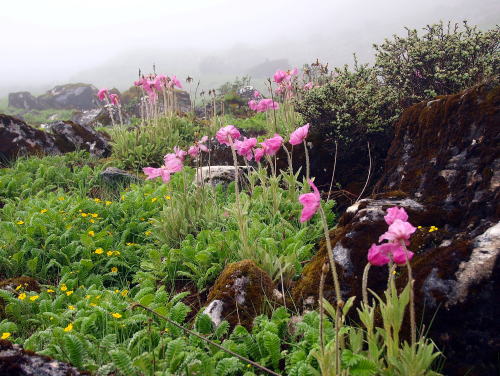 (Menchugan, alt. 4200m) (Menchugan, alt. 4200m) |
||||
We came back to Bumthang on the same road, but I could watch the flowers I couldn't meet on the ascending way. And also the weather was nice, so I had seen a wonderful sight. It became a fruitful trek. As we were able to return to Thimphu one day earlier, we visited the Institute for Biodiversity in Thimphu and watched samples of blue poppies it contained.
(2) Haa-Rigona Lake - Haa (circuit trip)
Haa prefecture was recently opened to foreigners (2010). Since the Chinese border is closer and an army (Indian army) was stationed, something felt pomp and circumstance even in a relaxed atmosphere.
Trekking started from the suburbs of Haa, the prefectural capital. When arriving the ridge in a day and a half, there was a rocky area and grassland where yaks were grazing..
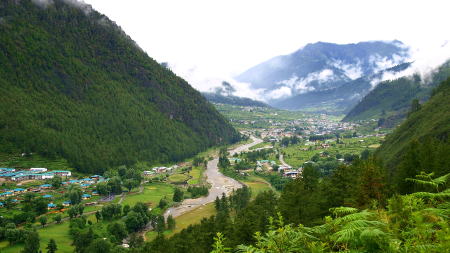 |
Distant view of Haa Valley Fish-rich Haa Chu (river) flows through the valley. (Bhutanese never eat fish because they admire them and worship for the religious reason). There is a monastery on the small hill in the center where our trekking started. The blue roof at the bottom left of the screen is the Indian Army garrison. (View from the motorway to Chele La) |
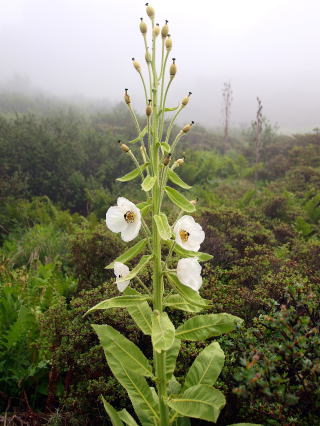 (Chishorumpa, alt. 4200m) |
Meconopsis superba This is one of large type of Meconopsis along with M. paniculata. The height well over 2m. It grows on the rock walls and places where there is a flow, such as the fall of a stream. This is the only meconopsis with white flowers except for albino. It is an endemic of Haa district.
|
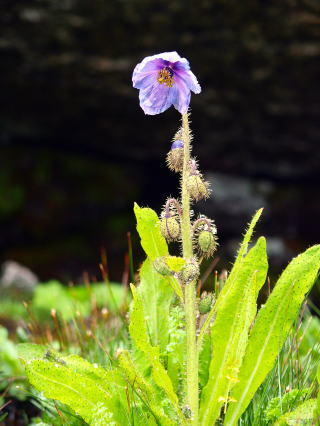 |
|
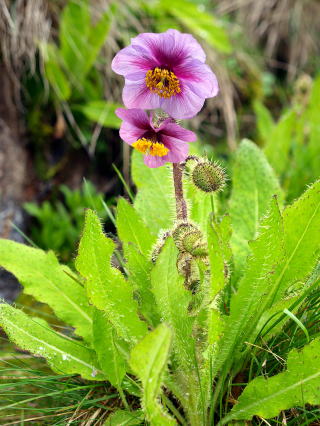 |
||||
|
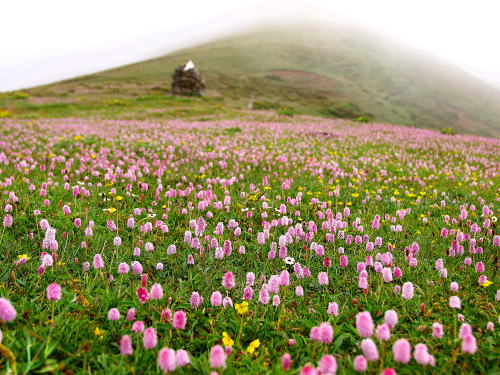 |
|||||
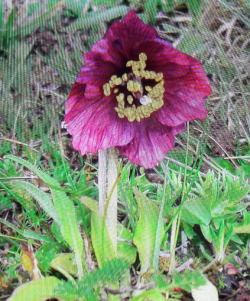 |
Potential new Meconopsis species A horseman accompanying with us took a shot of this flower with his smartphone near the Chinese border. (smartphone screen image) This area is strictly off-limited for foreigners due to military reasons. |
|||||
(3) Haa - Chele La - Paro
Chele La is a pass between Haa and Paro, the highest point is 3988m above the sea.
Poles of prayer flag, Darsin, are standing like trees on the pass, and Lunta are dancing with wind. If it is fine Jomolhari can be seen from there, but that day she was hidden in the clouds. Meconopsis were blooming on the steep slope further south from the pass.
Chele La is located in two and a half hours drive from Paro Airport. This is one of easy-access spots where you can find blue poppies conveniently.
1.jpg) |
←left
|
1.jpg) |
|||
1.jpg) |
Meconopsis paniculata
|
| Before entering Paro after descending from Chele La there is an Institute
of Seed Research (concurrently Agricultural Mechanization Center). Next
to it there is a small temple and a big Chorten (Stupa) in it. This is
the memorial tower and tomb of Kyoji Nishioka, a Japanese who is admired
by every Bhutanese. He had been dedicated his life to agricultural development
in Bhutan. For his effort the king of Bhutan gave him Dashaw (rank) and
a sword. He was the only foreigner who received such honor in Bhutan. When I visited here monk's sutra chanting were flowing out of the temple without stopping. |
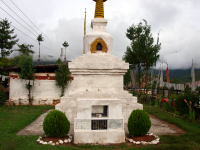 |
(4) Paro - Gunitsawa - Jomolhari BC (Jangothang) = Tsophu - Lingshi - Yale La - Thimphu(circuit trip)
This trekking course is the most popular in Bhutan and crowded by many trekkers in the high season (autumn to spring). However in the monsoon season the course is quiet while local peddlers were carrying cargo and Indian workers were conveying power development materials.
From Jomolhari Base Camp (BC), I followed the course that trekkers rarely go to and walked to Thimphu. It was a tough course that crossed 5 passes over 4500m, but there were many pleasant findings.
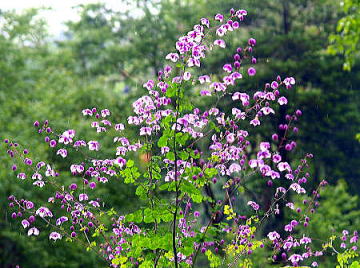 |
Thalictrum chelidonii (Himalayan Meadow Rue) Jomolhari trekking used to be started from Druk Zhong which has been abandoned due to fire, but now we can drive to Gunitsawa ahead of Shana, so we can shortened the trekking periods. Although the road is well maintained, as there is a lot of traffic for people and horses, so the road becomes muddy. On the 1st day we had no flowers to watch other than this Thalictrum before arriving campsite Tantanka, so we just walked. (between Gunitsawa and Tantanka, alt. 3400m) |
|||
When approaching Jomolhari BC, primroses and onosma began to appear as the surrounding scene moving to grasslands from forest belt. |
||||
|
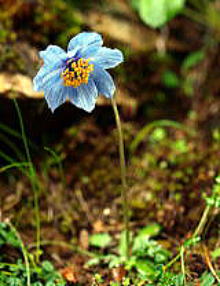 |
|||
Jomolhari BC is most crowded in the dry season (from September to April) when the top is clearly visible. At that time it is said that 400 tents were appeared at the campsite. This time, a European couple and myself occupied a large campsite.
The Goddess with 7314m high smiles at me though it was only about 30 minutes.
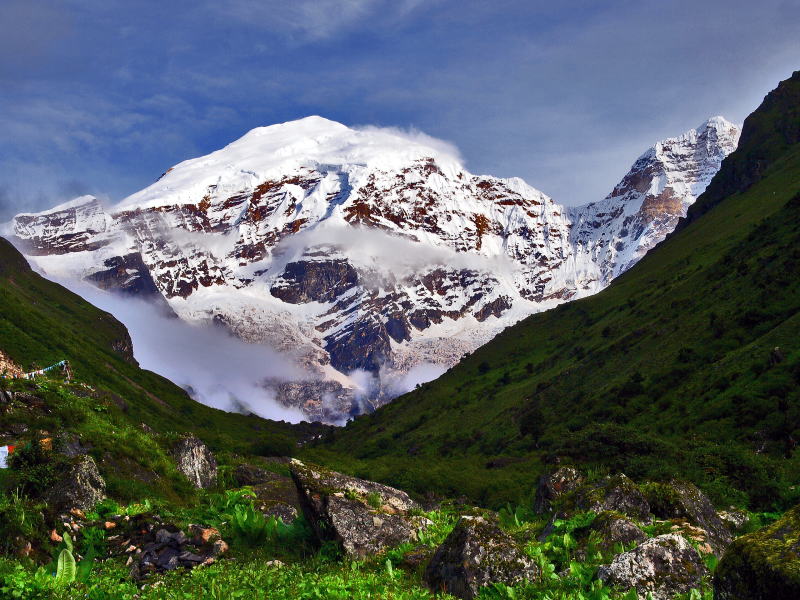 |
East face of Jomolhari |
My destination in Jomolhari BC was Lake Tsophu on the opposite side of Mt. Jomolhari. Ascending up 400m high to the top of end moraine (remains of glacier terminal) there are two lakes called Twin Lakes. Around the lakes there were many meconopisis blooming in addition to Bhutan's unique meconopsis.
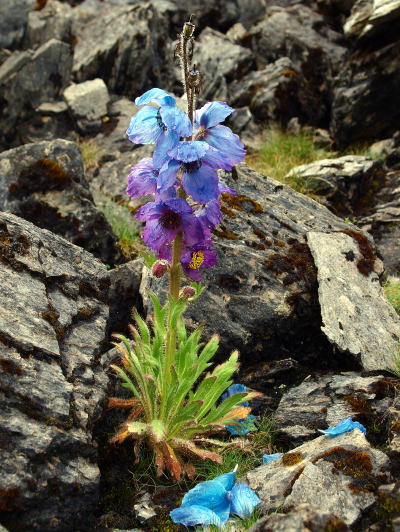 |
Meconopsis bhutanica
|
|||
|
2.jpg) |
We headed from Jomolhari BC, cross Nyili La (alt. 4764m) to Lingshi. There was yaks' summer pastures on the way, and they were grazing grass in relax.
In the scree over the pass, there were flowers of the Asteraceae wearing sweatshirts and flowers well-integrated with the scree circumstance.
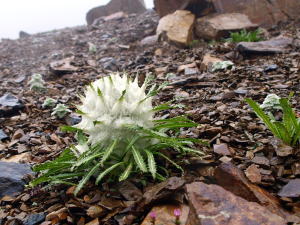 |
Saussurea gossipphora Wearing cotton to protect the flowers from the cold, so it is called a sweater plant. As the flower is also used as Chinese medicine, it is robbed and smuggled via Tibet. The army checkpoint has the duty to control smuggling. |
||
|
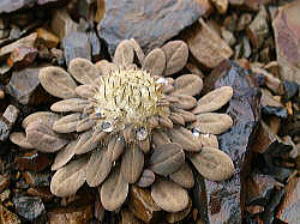 |
At this time Lingshi valley turns to a secret flower garden. Various flowers such as bistorta, primula, pediclaris, buttercups and so on are fully blooming along the stream.
M. Primulina is also dense and blooms every 1m here, so it is no longer a rare flower.
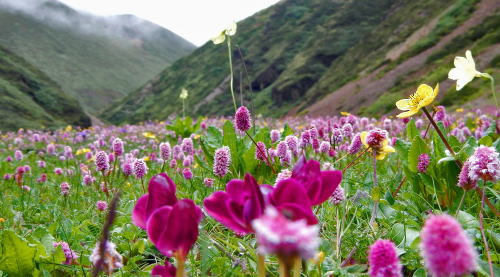 |
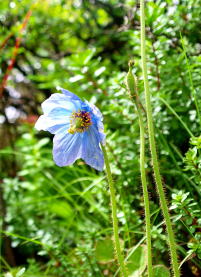 |
| (At the turnoff for Lingshi Zhong, alt. 4370m) | M. Primulina |
From the Lingshi campsite, the magnificent scene of the peaks and glaciers had been seen. It is said that even in the dry season trekkers are not able to see such a gorgeous landscape.
From the left, Jomolhari (small hump on the left), Jichu Drake (alt. 6989m), and Teringan (alt. 6789m). The small cabin in the meadow is an amy checkpoint.
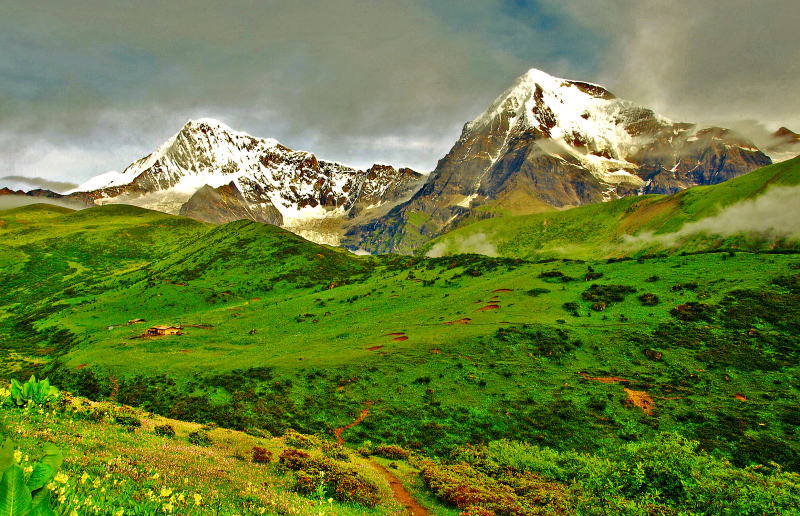
From here, we turned to south and passed through Yale La (alt. 4930m), Lhede La (alt. 4750m), Yasu La (alt. 4400m), and finally returned to Timphu. The course from Lhede La is the road that only local yak grazers can take, but it has wonderful views like Switzerland, and provides us with a rarely seen blue poppy.
3.jpg) |
Meconopsis horridula subsp. drukyuensis
|
||||
|
1.jpg) |
| Viewing southern valley (Shomthang valley) from Lhede La. Yaks are grazing leisurely. If they were milk cows, we were in Switzerland. | |
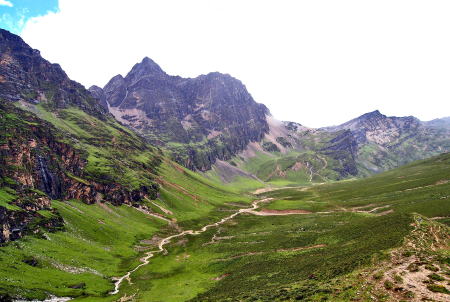 |
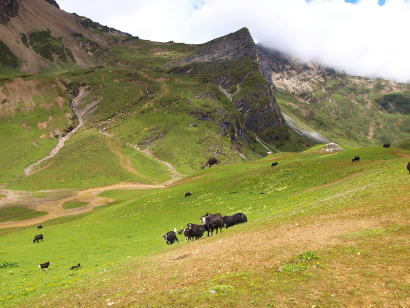 |
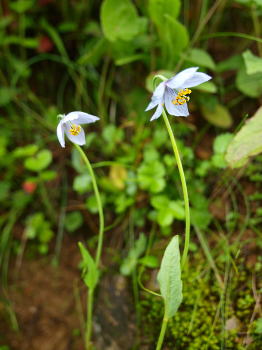 |
|
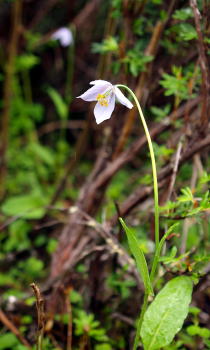 |
||||
|
.jpg) |
|||||
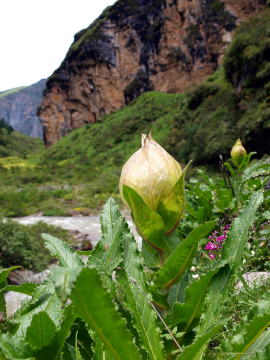 (glance at inside) |
Greenhouse plants protect their green shoots and young buds by curling leaves from cold. Also they provide a warm shelter to insects to carry their pollen.
|
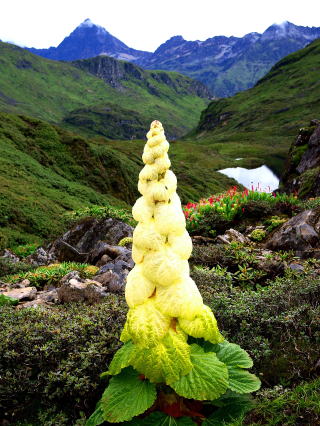 |
||||
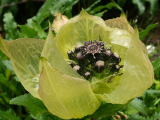 |
The difference is clear between Asteraceae (left) and Polygonaceae (right). | 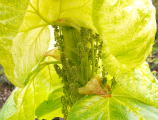 |
||||
After descending we stayed overnight at Monastery and returned to Thimphu. There is a plan to build a cable car from the trail start point near Thimphu to Phajoding. When it is completed, you will be able to see these rare alpine plants including blue poppies in one or two days. However, this may lead to make the trail road rough and littered (in fact there were a lot of garbage on the way to the holy lake Dung Tso from Phajoding).
As Bhutan is the country that prioritizes nature protection over development, so I hope it will not happen.
(5) Haa (Shana) = Tego La = Sele La = Haa (round trip)
The last trek is a two-day picnic at the base of the pass. As the president and his wife of a traveling company joined it was like a company trip with banquet. Since the flowering time of meconopsis seen here is from mid to late July, we decided to visit Haa twice.
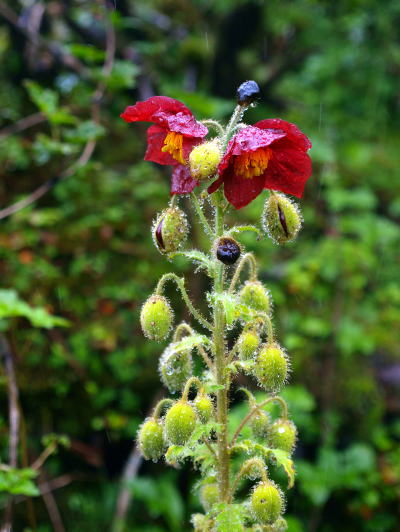 |
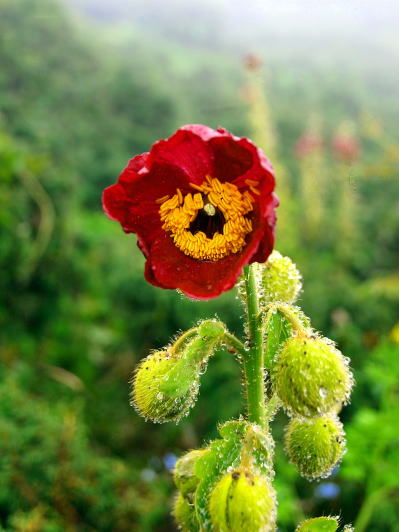 |
|
| Meconopsis wallichii subsp. fusco-purpurea | ||
|
||
This time I have not visited eastern Bhutan because I have been in Arunachal Pradesh of India last year (2015), where borders eastern Bhutan and I watched blue poppies there.There grows the national flower of Bhutan, Meconopsis gakyidiana (formerly known as M. grandis subsp. orientalis).
This flower was discovered in 1933 by the discover of pink poppies, George Sherriff, and reclassified as new species in 2016. However Bhutanese people even call M. horridula and M. simplicifolia as the national flower of Bhutan. What an easy-going country!
Meconopsis gakyidiana
|
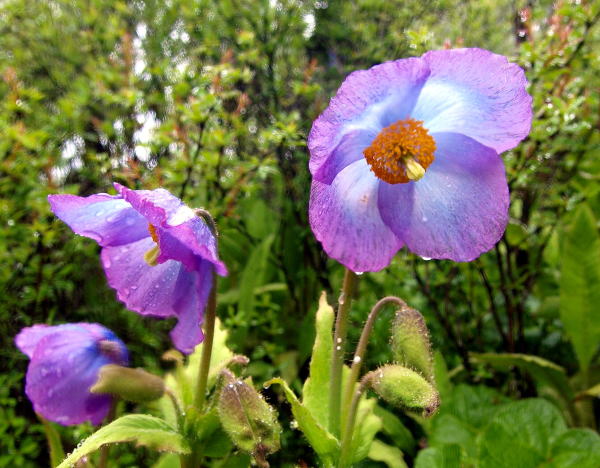 |
For over one month I have trekked with Bhutanese guides and staff and learned a lot about Bhutan and Bhutanese.
Bhutan has a national land area smaller than Japan's Kyushu island, with over 700,000 people (almost the same as Shimane Prefecture). However, she sends an ambassador to the United Nations and holds an army, two airline carriers, two mobile phone companies. The king has have enormous popularity and a high-support ratio, the matriarchal system remains strong, women live with vitality, and the habit of crawling at night still remains - a mysterious country!
I have also questioned about the National Happiness. If I have a chance I will tell you in the future.
